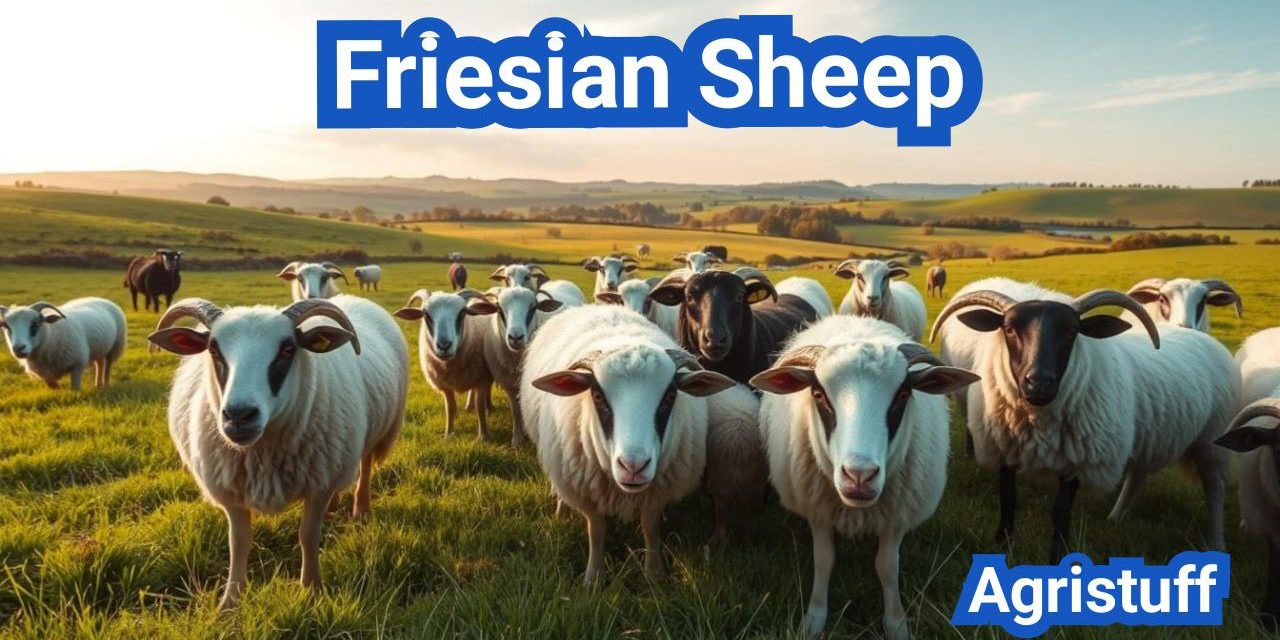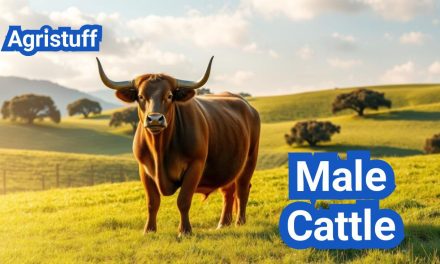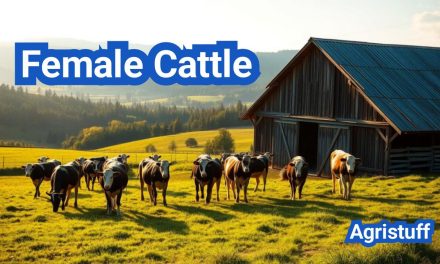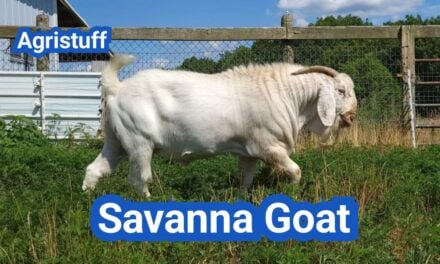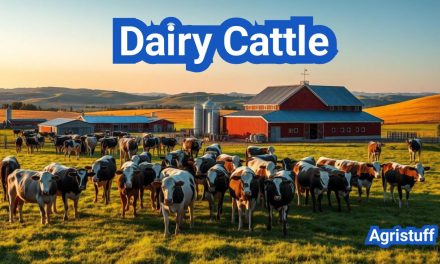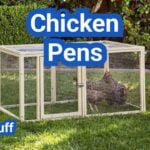The East Friesian Sheep is renowned for its exceptional milk production, making it a cornerstone in sheep dairy farming. Originating from the Friesland region in northern Europe, this breed has become a staple in dairy farming due to its prolific milk output and docile temperament.
Farmers value this breed for its unique characteristics, which make it ideal for cheese production and crossbreeding programs. With its high milk yield, the East Friesian Sheep plays a significant role in the dairy industry, particularly in Europe and North America.
Key Takeaways
- The East Friesian Sheep is a highly specialized dairy breed.
- It is known for its exceptional milk yield and docile temperament.
- This breed is ideal for cheese production and crossbreeding programs.
- The East Friesian Sheep is a cornerstone in sheep dairy farming.
- It plays a significant role in the dairy industry in Europe and North America.
The Origin and History of East Friesian Sheep
Originating in northern Germany and the Netherlands, the East Friesian Sheep has become a cornerstone in dairy farming. The breed’s history is deeply rooted in the Friesland region, where it was developed for its exceptional milk production capabilities.
German Roots and Development
The East Friesian Sheep breed was developed in the Friesland region of northern Germany, known for its fertile soil and favorable climate for dairy farming. The breed’s development focused on enhancing its milk production traits, resulting in one of the highest milk-producing sheep breeds globally.
The historical context of the East Friesian Sheep is closely tied to the agricultural practices of the Friesland region. The breed’s ability to produce high-quality milk made it an integral part of local dairy farming.
| Region | Characteristics | Milk Production (avg.) |
|---|---|---|
| Friesland, Germany | Fertile soil, favorable climate | 600-800 liters/lactation |
| Netherlands | Advanced dairy farming practices | 700-900 liters/lactation |
Introduction to North America
The East Friesian Sheep was introduced to North America in the late 20th century, bringing with it the promise of high milk production to the burgeoning sheep dairy industry in the USA. The breed quickly gained popularity among dairy farmers due to its superior milk production capabilities.
The introduction of the East Friesian Sheep to North America marked a significant milestone in the development of the sheep dairy industry in the region. The breed’s influence can be seen in the modern dairy farming practices that prioritize high milk production and quality.
Key factors in the breed’s adoption included:
- High milk production potential
- Adaptability to new farming environments
- Genetic diversity for crossbreeding programs
Understanding East Friesian Sheep Characteristics

Understanding the physical characteristics of East Friesian Sheep is essential for farmers looking to optimize their dairy operations. These characteristics not only define the breed but also play a significant role in their dairy production capabilities.
Size and Weight Specifications
East Friesian Sheep are classified as a medium-sized breed. Mature ewes typically weigh between 150-200 pounds, making them a manageable size for many dairy farming operations. Their size contributes to their popularity among dairy farmers, as it allows for efficient handling and care.
Distinctive Features and Appearance
One of the most distinctive features of East Friesian Sheep is their white wool, which is often accompanied by a “rat-tail” – a long, thin tail characteristic of the breed. They are also known for being polled, meaning they do not have horns. The combination of their white coat and polled heads gives them a unique appearance that is easily recognizable.
Black East Friesian Variants
While the majority of East Friesian Sheep are white, there is also a black variant. The black East Friesian Sheep offer a different aesthetic while maintaining the same dairy production qualities as their white counterparts. This variation in color does not affect their milk production capabilities.
| Characteristic | Description |
|---|---|
| Size | Medium |
| Mature Weight | 150-200 pounds |
| Wool Color | Primarily white, with black variants |
| Distinctive Feature | “Rat-tail” |
| Horns | Polled (no horns) |
Why East Friesian Sheep Lead Dairy Production Worldwide
The East Friesian Sheep breed is renowned for its exceptional milk production capabilities, making it a leader in dairy farming worldwide. With the ability to produce between 500-700 kg of milk per lactation, East Friesian Sheep stand out among other dairy sheep breeds.
Record-Breaking Milk Production Statistics
East Friesian Sheep are known for their impressive milk yield, with some individuals producing over 700 kg of milk in a single lactation period. This high milk production is a result of careful breeding and selection for dairy traits.
Milk Production Statistics:
| Lactation Period | Milk Yield (kg) |
|---|---|
| Average | 500-700 |
| Record-Breaking | over 700 |
Comparison to Other Dairy Sheep Breeds
When compared to other dairy sheep breeds, East Friesian Sheep excel in terms of milk production. Their high yield and rich milk composition make them an ideal choice for dairy farming and cheese production.
A comparison of milk production statistics among various dairy sheep breeds highlights the superiority of East Friesian Sheep:
| Breed | Milk Yield (kg) |
|---|---|
| East Friesian | 500-700 |
| Lacaune | 300-500 |
| Sarda | 200-400 |
How to Measure and Maximize East Friesian Milk Yield

To optimize milk production from East Friesian Sheep, farmers must consider several key factors, including daily production rates and nutritional profiles. Understanding these elements is crucial for maximizing milk yield and ensuring the overall health and productivity of the flock.
Average Milk Production Per Day
East Friesian Sheep are known for their high milk production, with an average yield of 1.5 to 2 kg of milk per day. This breed’s exceptional dairy capabilities make them a popular choice among dairy farmers worldwide.
Lactation Period and Annual Production
The lactation period for East Friesian Sheep typically lasts around 220-230 days. Over this period, the total milk production can be substantial, making them highly productive dairy animals. Farmers can expect a significant annual milk yield, contributing to the economic viability of their dairy operations.
Nutritional Profile of East Friesian Milk
East Friesian milk is not only produced in high quantities but is also rich in nutrients. It has a high butterfat and protein content, making it ideal for producing cheese, yogurt, and other dairy products. The nutritional profile of East Friesian milk includes:
- High butterfat content, enhancing its suitability for cheese production
- Rich protein content, contributing to its nutritional value
- Excellent for producing a variety of dairy products, from cheese to yogurt
To maximize milk yield, farmers should focus on providing optimal nutrition, ensuring proper health care, and implementing effective milking practices. By understanding and addressing these factors, dairy farmers can significantly enhance the productivity of their East Friesian Sheep.
Setting Up Your East Friesian Sheep Dairy Operation
The journey to setting up an East Friesian Sheep dairy farm in the USA involves several critical steps, from infrastructure development to regulatory compliance. Establishing a successful dairy operation requires a comprehensive understanding of the necessary components to manage the flock effectively and produce high-quality milk.
Essential Infrastructure Requirements
To begin, the infrastructure for your East Friesian Sheep dairy operation must be well-planned. This includes:
- Sheep Housing: Providing adequate shelter that protects the sheep from extreme weather conditions and predators.
- Milking Parlour: A clean, well-designed milking parlour is crucial for efficient milking and maintaining milk quality.
- Pasture Management: Ensuring sufficient grazing land and implementing rotational grazing practices to maintain pasture health.
According to dairy farming experts, “A well-designed milking facility is essential for the efficiency and hygiene of the milking process”
Equipment Needed for Milking
The right milking equipment is vital for the efficient and hygienic production of milk. This includes:
| Equipment | Description |
|---|---|
| Milking Machines | Designed for efficient milk extraction, reducing labor and stress on the sheep. |
| Milking Stood | Provides a comfortable position for the sheep during milking. |
| Milk Cooling System | Essential for maintaining milk quality by cooling it to the appropriate temperature immediately after milking. |
Regulatory Considerations in the US
Compliance with local and national regulations is crucial for the legitimacy and success of your dairy operation. Key regulatory considerations include:
- Health and Safety Standards: Adhering to guidelines that ensure the health and safety of both the sheep and the personnel.
- Milk Quality Regulations: Meeting standards for milk quality, including bacterial counts and somatic cell counts.
- Environmental Regulations: Complying with regulations related to waste management and environmental impact.
By carefully planning your infrastructure, acquiring the necessary milking equipment, and adhering to regulatory requirements, you can establish a successful East Friesian Sheep dairy operation in the USA.
Step-by-Step Guide to Milking East Friesian Sheep

To get the most out of your East Friesian Sheep dairy operation, it’s crucial to master the milking process. Milking East Friesian Sheep effectively requires a thorough understanding of the process, from preparing the sheep to the actual milking.
Preparing the Sheep for Milking
Before milking, it’s essential to prepare the East Friesian Sheep properly. This involves ensuring the sheep are clean and comfortable. The udder and teats should be cleaned with a gentle disinfectant to prevent bacterial contamination. The sheep should also be well-fed and have access to fresh water to enhance milk production.
- Clean the udder and teats with a disinfectant.
- Ensure the sheep are well-fed and hydrated.
- Provide a comfortable milking environment.
Hand Milking Techniques
Hand milking is a traditional method that requires skill and gentleness. To milk East Friesian Sheep by hand effectively:
- Hold the teat in your hand, with your thumb and index finger forming a ‘C’ shape around the top of the teat.
- Close your thumb and index finger to trap the milk in the teat.
- Use your other fingers to strip the milk from the teat, starting from the top.
- Release your thumb and index finger to allow the teat to refill with milk.
Tip: Be gentle to avoid causing discomfort or injury to the sheep.
Machine Milking Procedures
Machine milking is a more efficient method for larger dairy operations. When using machine milking for East Friesian Sheep:
- Ensure the milking machine is properly calibrated and maintained.
- Attach the milking cluster gently to the sheep’s teats.
- Monitor the milking process to prevent over-milking.
Regardless of the milking method, maintaining hygiene and being gentle with the sheep are crucial for high-quality milk production and the overall health of the flock.
How to Feed East Friesian Sheep for Optimal Milk Production

Feeding East Friesian Sheep for optimal milk production requires a deep understanding of their nutritional needs. East Friesian Sheep are renowned for their high milk yield, and a well-balanced diet is crucial to support this production.
Nutrition Requirements Throughout Lactation
The nutritional requirements of East Friesian Sheep vary throughout their lactation period. During early lactation, the energy requirements are higher to support the onset of milk production. As lactation progresses, these requirements adjust, necessitating changes in their dietary regimen.
Nutritional Needs:
- Energy: High energy requirements during early lactation
- Protein: Adequate protein is essential for milk production
- Calcium and Phosphorus: Crucial for milk production and overall health
As noted by dairy farming experts, “A diet that is deficient in any of these nutrients can lead to reduced milk yield and health issues in the flock.”
Forage and Concentrate Ratios
The ratio of forage to concentrate is critical in the diet of East Friesian Sheep. Forage provides fiber, which is essential for rumen health, while concentrates offer the necessary energy and protein for milk production.
A general guideline is to maintain a forage-to-concentrate ratio that supports both rumen health and milk production. For instance:
| Lactation Stage | Forage (%) | Concentrate (%) |
|---|---|---|
| Early Lactation | 50 | 50 |
| Mid Lactation | 60 | 40 |
| Late Lactation | 70 | 30 |
Supplementation Strategies
In addition to forage and concentrates, supplementation strategies may be necessary to ensure that the flock receives a balanced diet. This can include vitamins and minerals that are crucial for overall health and milk production.
Supplementation Considerations:
- Vitamin D for calcium absorption
- Selenium to prevent white muscle disease
- Other trace minerals as needed based on soil and forage analysis
By understanding and implementing these feeding strategies, dairy farmers can optimize the milk production of their East Friesian Sheep, ensuring a healthy and productive flock.
Evaluating and Utilizing East Friesian Sheep Wool

While milk production is the primary focus of East Friesian Sheep farming, the wool produced by these sheep is also of significant value. The characteristics of their wool, along with proper shearing and processing techniques, can contribute to the overall profitability of a sheep dairy operation.
Wool Quality Characteristics
East Friesian Sheep produce wool that is generally white and of medium quality. The fleece is characterized by its softness and a staple length that can vary depending on factors such as genetics and nutrition. According to sheep breeders, “The wool from East Friesian Sheep is highly regarded for its softness and is often used in the production of high-quality textiles.”
Wool Quality Parameters:
- Fineness: 30-40 microns
- Staple Length: 3-5 inches
- Clean Yield: 50-60%
Shearing Techniques and Timing
Proper shearing techniques are crucial to maintaining the quality of the wool. Shearing once or twice a year, depending on the climate and the sheep’s fleece condition, is common practice. “Shearing should be done with care to avoid cuts and stress to the animal,” as emphasized by experienced shepherds.
Best Practices for Shearing:
- Shear during the spring or fall when the weather is mild.
- Use clean, sharp shearing equipment.
- Handle the sheep gently to minimize stress.
Processing and Marketing East Friesian Wool
After shearing, the wool needs to be processed, which includes sorting, cleaning, and packaging. The processed wool can then be marketed to textile manufacturers or sold directly to crafters and spinners. “The demand for high-quality, soft wool like that from East Friesian Sheep is on the rise, driven by the textile industry’s need for premium materials.”
Marketing Strategies:
- Direct sales to textile mills or craft suppliers.
- Online marketing through dedicated wool sales platforms.
- Local farmers’ markets or craft fairs.
By focusing on the quality and proper handling of East Friesian Sheep wool, farmers can tap into a valuable secondary revenue stream, enhancing the overall viability of their dairy sheep operations.
Raising East Friesian Sheep for Meat Production

The versatility of East Friesian Sheep extends to meat production, providing farmers with an additional revenue stream. While they are primarily known for their exceptional dairy capabilities, East Friesian Sheep can also be raised for high-quality meat.
Growth Rates and Carcass Yields
East Friesian lambs are known for their relatively fast growth rates, making them a viable option for meat production. Studies have shown that East Friesian crossbred lambs can achieve average daily gains of up to 0.4 kg per day under optimal feeding conditions.
The carcass yields of East Friesian lambs are also noteworthy. Research indicates that they can produce carcasses with a high proportion of lean meat, which is desirable in the market.
| Breed | Average Daily Gain (kg) | Carcass Yield (%) |
|---|---|---|
| East Friesian | 0.35 | 50 |
| East Friesian Cross | 0.40 | 52 |
Finishing Methods for Market Lambs
Finishing methods for East Friesian market lambs can significantly impact their quality and market value. Common finishing practices include grazing on high-quality pastures and supplementation with concentrates to enhance growth rates and meat quality.
Grazing: Allows lambs to grow at a natural pace and can result in a more favorable fatty acid profile in the meat.
Concentrate Supplementation: Can accelerate growth rates and improve carcass yields, making lambs ready for market sooner.
Meat Quality and Marketing Opportunities
The meat from East Friesian Sheep is characterized by its leanness and tenderness, making it appealing to consumers looking for high-quality lamb products. Marketing strategies can focus on the breed’s unique characteristics, such as its dairy background and the resultant meat quality.
Marketing Opportunities: Include promoting the meat through local farmers’ markets, specialty butcher shops, and online platforms that cater to consumers seeking premium lamb products.
How to Implement Successful East Friesian Crossbreeding Programs

To maximize the benefits of East Friesian sheep in dairy farming, farmers can implement crossbreeding programs that leverage hybrid vigor. Crossbreeding East Friesian sheep with other breeds can lead to improved milk production and hardiness, making dairy farming more efficient and profitable.
Selecting Compatible Breeds
The success of an East Friesian crossbreeding program largely depends on selecting compatible breeds. Breeds that complement the East Friesian’s high milk production and are known for their hardiness or other desirable traits are ideal. For instance, breeds like the Lacaune or Awassi can be considered for their milk production capabilities and adaptability to various environments.
- Consider breeds known for their milk production and hardiness.
- Evaluate the genetic diversity of the breeds to ensure a robust crossbreeding program.
- Assess the adaptability of the breeds to your specific farming conditions.
First-Generation Cross Performance
The performance of first-generation crosses can be quite promising, often displaying hybrid vigor. This can result in improved milk production, better growth rates, and increased resistance to diseases. For example, crossing East Friesian ewes with rams from a hardy breed can produce offspring that are not only high producers but also more resilient to environmental stresses.
“Crossbreeding can significantly enhance the productivity and hardiness of dairy sheep flocks, making it a valuable strategy for dairy farmers.”
Maintaining Hybrid Vigor in Your Flock
To maintain hybrid vigor in your flock, it’s crucial to implement a well-planned breeding strategy. This involves avoiding inbreeding, introducing new genetics periodically, and selecting for desirable traits. Regular monitoring of the flock’s performance and health is also essential to make informed breeding decisions.
- Develop a breeding plan that avoids inbreeding and promotes genetic diversity.
- Regularly assess the performance and health of your crossbred animals.
- Adjust your breeding strategy as needed based on the outcomes.
Selecting Quality East Friesian Breeding Stock

The success of a dairy farming operation hinges on selecting superior East Friesian breeding stock. This critical decision directly impacts the productivity and profitability of the farm.
Evaluating Milk Production Traits
When selecting East Friesian breeding stock, evaluating milk production traits is paramount. This involves assessing the quantity and quality of milk produced by the ewes. High-producing ewes with a history of consistent milk production are ideal for dairy operations.
Farmers should look for breeding stock with documented milk production records. The average milk production per day and the lactation period are crucial factors to consider.
| Milk Production Trait | Ideal Characteristic |
|---|---|
| Average Milk Production per Day | High volume (e.g., 3-4 liters/day) |
| Lactation Period | Longer lactation (e.g., 200-250 days) |
| Milk Quality | High fat and protein content |
Assessing Physical Conformation
The physical conformation of East Friesian breeding stock is another critical factor. Ewes with a well-structured udder and good overall body condition are preferable.
“The udder should be well-attached, with a good balance between the two halves, and the teats should be of a suitable size and shape for efficient milking.”
Assessing the overall health and body condition of the ewes is also essential. A healthy ewe with good conformation is more likely to produce high-quality milk and have a longer productive life.
Health and Genetic Considerations
Health and genetic considerations are vital when selecting East Friesian breeding stock. Farmers should look for stock from herds with a known health status and genetic history.
Genetic testing can help identify potential genetic disorders or traits that could impact milk production or the overall health of the flock. Selecting breeding stock with a strong genetic background can help maintain a healthy and productive flock.
- Look for breeding stock from health-tested herds.
- Consider genetic testing for inherited disorders.
- Choose stock with a documented genetic history.
By carefully evaluating milk production traits, assessing physical conformation, and considering health and genetic factors, farmers can select high-quality East Friesian breeding stock that will enhance the productivity and profitability of their dairy operation.
Year-Round Management Guide for East Friesian Sheep

To optimize the health and productivity of East Friesian Sheep, farmers must adopt a year-round management strategy. This involves understanding and addressing the seasonal needs of the flock, managing lambing effectively, and maintaining overall health through parasite control and other measures.
Seasonal Care Requirements
East Friesian Sheep have different needs across various seasons. In the spring, it’s crucial to ensure that the sheep have adequate nutrition to support their health and milk production. Summer care involves managing heat stress and ensuring access to quality pasture. Autumn preparations are key for winter, including stockpiling forage and maintaining facilities.
- Spring: Focus on nutrition and milk production support.
- Summer: Manage heat stress and ensure quality pasture.
- Autumn: Prepare for winter by stockpiling forage and maintaining facilities.
- Winter: Ensure adequate shelter and nutrition.
Lambing Management Techniques
Lambing management is a critical aspect of East Friesian Sheep farming. It involves preparing the ewes for lambing, monitoring the lambing process, and ensuring the health of both ewes and lambs post-lambing.
Key lambing management techniques include:
- Preparing ewes nutritionally and by ensuring they are in good health before lambing.
- Monitoring ewes during lambing to assist if necessary.
- Ensuring lambs receive adequate colostrum and are healthy.
Health Maintenance and Parasite Control
Maintaining the health of East Friesian Sheep involves regular health checks, vaccinations, and parasite control measures. Parasite control is crucial to prevent internal parasites that can significantly impact the health and productivity of the flock.
Effective health maintenance strategies include:
- Regular veterinary checks and vaccinations.
- Implementing a parasite control program tailored to the farm’s specific needs.
- Maintaining clean living conditions for the sheep.
By adopting these year-round management practices, farmers can ensure the health, productivity, and profitability of their East Friesian Sheep flock.
Processing East Friesian Sheep Milk into Value-Added Products
Processing East Friesian Sheep milk into various dairy products is a lucrative opportunity for dairy farmers looking to diversify their offerings. The rich nutritional profile of this milk makes it ideal for creating high-quality, value-added products.
Cheese Production Techniques
East Friesian Sheep milk is particularly well-suited for cheese production due to its high fat content and rich flavor profile. Artisanal cheeses made from this milk are highly prized for their creamy texture and nuanced taste. To produce high-quality cheese, dairy farmers must adhere to strict hygiene standards and employ traditional cheese-making techniques.
- Select high-quality milk from healthy East Friesian Sheep.
- Ensure proper pasteurization and handling to maintain milk quality.
- Use traditional cheese-making techniques to craft unique, artisanal cheeses.
Yogurt and Other Dairy Products
In addition to cheese, East Friesian Sheep milk can be used to produce a variety of other dairy products, including yogurt, butter, and ice cream. The high protein content of this milk makes it particularly suitable for producing thick, creamy yogurts with a rich texture.
- Prepare the milk by pasteurizing and cooling it to the appropriate temperature.
- Add yogurt cultures and incubate until the desired consistency is achieved.
- Customize the yogurt with flavorings or sweeteners as desired.
Equipment and Facility Requirements
To process East Friesian Sheep milk into value-added dairy products, dairy farmers must invest in appropriate equipment and facilities. This includes milking machines, pasteurizers, cheese-making equipment, and storage facilities for the finished products.
Ensuring that all equipment is properly sanitized and maintained is crucial for producing high-quality dairy products. Additionally, facilities must meet regulatory standards for dairy production, including proper ventilation, lighting, and waste management.
Sheep Dairy Farming in the USA: Challenges and Opportunities
The landscape of sheep dairy farming in the USA is characterized by a delicate balance between challenges and opportunities.
Current Market Landscape
The market for sheep dairy products in the United States is niche but growing, driven by consumer demand for specialty cheeses and dairy products.
Key market trends include:
- Increasing demand for artisanal cheeses
- Growth in the organic and natural products sector
- Rising popularity of sheep dairy products due to their unique nutritional profile
Regulatory Hurdles and Solutions
Sheep dairy farmers in the USA face several regulatory challenges, including compliance with dairy sanitation standards and environmental regulations.
To overcome these hurdles, farmers can:
- Stay informed about changing regulations through industry associations
- Implement best practices in dairy hygiene and waste management
- Explore organic certification to access premium markets
Success Stories and Business Models
Despite the challenges, many sheep dairy farms in the USA have achieved success through innovative business models and a focus on quality.
Successful strategies include:
- Diversifying product lines to include value-added dairy products
- Developing direct-to-consumer sales channels through farmers’ markets and online platforms
- Collaborating with other local producers to create a robust regional dairy industry
By understanding the current market landscape, navigating regulatory requirements, and learning from successful business models, sheep dairy farmers in the USA can capitalize on the opportunities in this growing niche.
Economic Analysis of East Friesian Sheep Farming
The economics of East Friesian Sheep farming involve various factors, including initial investment and operational costs. To succeed in this venture, farmers must carefully evaluate these economic implications.
Initial Investment and Sheep Pricing
The initial investment in East Friesian Sheep farming includes the cost of purchasing the sheep and setting up the necessary infrastructure. The price of East Friesian Sheep can vary based on factors such as breed quality, age, and location.
Initial Investment Breakdown:
| Component | Cost Range |
|---|---|
| East Friesian Sheep (per head) | $200 – $500 |
| Milking Equipment | $1,000 – $3,000 |
| Infrastructure (barns, fencing) | $5,000 – $10,000 |
Operational Costs and Returns
Operational costs for East Friesian Sheep farming include feed, veterinary care, and labor. The returns are primarily generated from the sale of milk and dairy products.
Key Operational Costs:
- Feed costs: $500 – $1,000 per month
- Veterinary care: $200 – $500 per year
- Labor costs: $1,000 – $2,000 per month
The average milk production per East Friesian Sheep can range from 200 to 400 liters per lactation period, with the potential for significant returns through dairy sales.
Marketing Channels for Sheep Dairy Products
Effective marketing channels are crucial for the success of East Friesian Sheep dairy farming. Farmers can explore various avenues, including direct sales to consumers, partnerships with local businesses, and online marketing.
Marketing Strategies:
- Direct-to-consumer sales through farm gates or farmers’ markets
- Partnerships with local cheese makers or bakeries
- Online sales through e-commerce platforms
By understanding the economic aspects of East Friesian Sheep farming, including initial investments, operational costs, and marketing channels, farmers can make informed decisions to ensure the profitability of their operations.
The Future of East Friesian Sheep in American Agriculture
The East Friesian Sheep breed is poised to play a significant role in the future of American agriculture, driven by the growing demand for sheep dairy products. With their exceptional milk production capabilities, these sheep are becoming increasingly popular among dairy farmers in the United States.
As the sheep dairy industry continues to evolve, the role of East Friesian Sheep is likely to expand, offering opportunities for farmers to diversify their operations and capitalize on the growing market for sheep dairy products. The future prospects for East Friesian Sheep in American agriculture look promising, with potential for growth and development in the coming years.
By understanding the characteristics, management, and production capabilities of East Friesian Sheep, farmers and industry stakeholders can work together to promote the breed and drive the success of the sheep dairy industry in the United States, ultimately contributing to the diversity and resilience of American agriculture.
FAQ
What is the average milk production per day of East Friesian Sheep?
East Friesian Sheep produce an average of 1.5 to 2 kg of milk per day over a lactation period of 220-230 days.
What are the characteristics of East Friesian Sheep?
East Friesian Sheep are characterized by their white wool, polled heads, and a distinctive “rat-tail.” They are medium-sized, with mature ewes weighing between 150-200 pounds.
How much milk can East Friesian Sheep produce in a lactation period?
East Friesian Sheep can produce between 500-700 kg of milk per lactation.
What is the nutritional profile of East Friesian Sheep milk?
East Friesian Sheep milk is rich in nutrients, with a high butterfat and protein content, making it ideal for cheese and dairy products.
What are the essential infrastructure requirements for setting up an East Friesian Sheep dairy operation?
Essential infrastructure requirements include the right facilities and equipment to manage the flock effectively and produce high-quality milk.
How do you milk East Friesian Sheep effectively?
Milking East Friesian Sheep effectively requires a thorough understanding of the process, from preparing the sheep to the actual milking, whether using hand milking techniques or machine milking procedures.
What are the nutritional requirements of East Friesian Sheep throughout lactation?
The nutritional needs of East Friesian Sheep change throughout the lactation period, requiring adjustments in forage and concentrate ratios, and supplementation strategies may be necessary.
Can East Friesian Sheep be raised for meat production?
Yes, East Friesian Sheep can be raised for meat production, with lambs having a relatively fast growth rate, and the meat being lean and of high quality.
What are the benefits of crossbreeding East Friesian Sheep?
Crossbreeding East Friesian Sheep with other breeds can result in improved milk production and hardiness, with the performance of first-generation crosses being particularly promising.
How do you select quality East Friesian breeding stock?
Selecting quality East Friesian breeding stock involves evaluating milk production traits, assessing physical conformation, and considering health and genetic factors.
What are the challenges and opportunities in sheep dairy farming in the USA?
Sheep dairy farming in the USA is a niche industry with its own set of challenges, including regulatory hurdles, and opportunities, such as a growing demand for sheep dairy products.
What is the economic analysis of East Friesian Sheep farming?
The economic analysis of East Friesian Sheep farming involves considering the initial investment, operational costs, and potential returns, as well as identifying effective marketing channels for sheep dairy products.
What is the future of East Friesian Sheep in American agriculture?
The East Friesian Sheep has a bright future in American agriculture, driven by the growing demand for sheep dairy products and the breed’s exceptional milk production capabilities.
Conclusion Of: East Friesian Sheep
If you’re exploring the world of dairy sheep, East Friesian Sheep should be on your radar. Recognized as Europe’s leading milking sheep breed—and often called the “Holstein of sheep”—they stand out for their impressive milk production, fertility, and adaptability in intensive dairy systems. Let’s dive into what makes East Friesian Sheep so special.
Learn more about dairy sheep breeds from the University of Wisconsin-Madison Extension.
Origins and History of East Friesian Sheep
East Friesian Sheep trace their roots to the coastal marshlands of Ostfriesland (East Friesland) in northern Germany and the Netherlands. Developed through centuries of selective breeding, they were optimized for high milk output in barn-based dairy systems during the 18th and 19th centuries. With records dating back to the establishment of breed registries in the late 1800s, East Friesian Sheep became the backbone of Northern Europe’s sheep‑milk industry.
Explore the history of European sheep breeds via FAO (Food and Agriculture Organization).
Distinctive Appearance and Traits
Every East Friesian Sheep features a characteristic wool‑less “rat tail,” pink nose, and clean white face and legs. They are typically polled (hornless) and have pale hooves. Their wool is medium textured (approximately 35–37 microns) and grows in a staple length of 120–160 mm, weighing around 4–5 kg per fleece.
Read about sheep breed standards from the American Sheep Industry Association.
Milk Production Powerhouse
East Friesian Sheep are renowned for extraordinary milk yields, typically delivering between 500 and 700 kg per 210–230‑day lactation—far more than any other purebred dairy sheep. Some exceptional individuals have produced up to 900 kg. Milk composition is rich: usually 6–7 % butterfat and around 6 % protein.
Compare dairy sheep milk yields with data from Penn State Extension.
Fertility and Reproductive Efficiency
One standout feature of East Friesian Sheep is their high prolificacy. Mature ewes average over two lambs per lambing (200–220 %), often matching that rate even as yearlings. East Friesian-cross ewes in the U.S. have shown 0.27 more lambs and nearly double milk yield compared to Dorset-cross ewes.
Study sheep reproductive efficiency via Oregon State University Extension.
Adaptability and Cross‑Breeding Success
While East Friesian Sheep thrive under intensive, well‑managed conditions, they are less suited for harsh climates or extensive grazing systems. However, when used in cross‑breeding, their strengths shine:
- Lacaune × East Friesian crosses used in Wisconsin offer exceptional milk yield combined with richer milk solids.
- Awassi × East Friesian crosses (Assaf) are well‑adapted to arid climates and show improved milk and fertility.
These crosses provide hybrid vigor, often leading to resilient, productive dairy ewes.
Discover crossbreeding strategies from USDA Sheep Genetics.
Why East Friesian Sheep Are Ideal for Dairy Farming
- Top-tier milk yield: Surpassing 500 kg of milk per lactation with rich nutrient content, East Friesian Sheep are unmatched among sheep.
- High fertility: With twin‑bearing rates over 200 %, they maximize lamb output along with milk.
- Friendly and easy to handle: Bred in barn dairies for centuries, East Friesian Sheep are docile and trainable, ideal for parlor systems.
- Valuable wool byproduct: Their wool, though not the primary goal, is medium‑textured and suitable for various craft uses.
See dairy sheep management guides from University of Minnesota Extension.
Management Essentials
- Feeding requirements: To hit high milk targets, East Friesian Sheep need nutrient‑dense rations and high‑quality forage, preferably legume‑grass mixes.
- Health vigilance: Susceptible to parasites and pneumonia, regular monitoring and prevention strategies are crucial.
- Environmental requirements: They prefer milder climates; hot weather and relentless pasture-based grazing are not ideal unless crosses are used.
- Milking logistics: Require structured milking schedules—usually twice daily when lambs are housed, or once daily post‑30 days.
Learn about sheep nutrition from Cornell University’s Small Ruminant Program.
East Friesian Sheep in North America
Since their importation in the 1990s, East Friesian Sheep and their crosses have become North America’s most popular dairy sheep. The University of Wisconsin’s Extension and Spooner station’s trials demonstrated superior productivity of East Friesian-cross ewes compared to traditional breeds.
Read UW-Madison’s research on dairy sheep productivity.
Farms like WoolDrift in Ontario pioneered commercial East Friesian dairy through embryo importation in 1994 and set a model for breeding. Blue Oaks Ranch in California also highlights the breed’s ease of training and suitability as a “barn buddy.”
Explore commercial sheep dairies via American Dairy Goat Association (sheep resources).
Milk Value for Cheeses and Dairy Products
Sheep milk is cheese gold. East Friesian Sheep’ milk, with its high solids, yields about twice the cheese per unit volume compared to cow’s milk. It supports premium cheeses like feta, pecorino, and artisanal Dutch‑style varieties. Combined with the traditional creaminess of 6–7% butterfat and protein, it’s ideal for specialty dairy products.
FDA guidelines on sheep milk cheese production.
Human Health Benefits
Nutritionally, East Friesian Sheep produce milk that’s richer in vitamins (A, B2, B12, E) and minerals (calcium, phosphorus, magnesium) than cow milk. The smaller fat globules and different protein structure make it potentially easier to digest for some individuals. It’s a nutrient-dense alternative suitable for cheese, yogurt, and even ice cream.
Read about sheep milk nutrition from National Institutes of Health (NIH).
Meat and Wool Value
Although primarily dairy, East Friesian Sheep still produce lean, flavorful lamb. Rams and cull ewes contribute to the meat market—lean, high-protein meat rich in B12, iron, zinc, omega‑3, and CLA. Their wool, with a micron of around 29‑37 µm and a staple of 4–6 in, is great for spinning and crafting.
USDA lamb meat nutrition facts.
Challenges to Address
- Climate sensitivity: Pure East Friesian Sheep struggle in extreme climates; crossbreeding is often necessary.
- Intensive care needed: Their high nutritional and health needs demand consistent management.
- Initial investment: Importing genetics and setting up milking infrastructure involves significant cost and biosecurity measures.
- Demand for forage quality: They need legume-rich pasture and tailored supplementation to maintain yields.
USDA’s guide to small-scale sheep dairying.
Future Outlook in the USA
The U.S. sheep dairy industry is growing, led by East Friesian Sheep and their crosses. Genetic imports, supportive breed associations, and consumer interest in artisanal dairy offer expansion prospects. As infrastructure and knowledge evolve, dairy sheep farming—especially with this elite breed—can thrive as a sustainable niche in American agriculture.
Latest trends in U.S. sheep farming from USDA Economic Research Service.
Final Thought
East Friesian Sheep offer unmatched milk production, fertility, and product versatility among dairy sheep. Ideal for farmers aiming to produce cheese, yogurt, and premium lamb, they do require focused care and smart breeding strategies. Their status as Europe’s top dairy sheep—and North America’s rising dairy star—reflects a powerful mix of tradition and productivity. With thoughtful management, they can transform small to mid‑scale farms into vibrant, diversified enterprises.
Comprehensive dairy sheep manual from University of California Agriculture.

